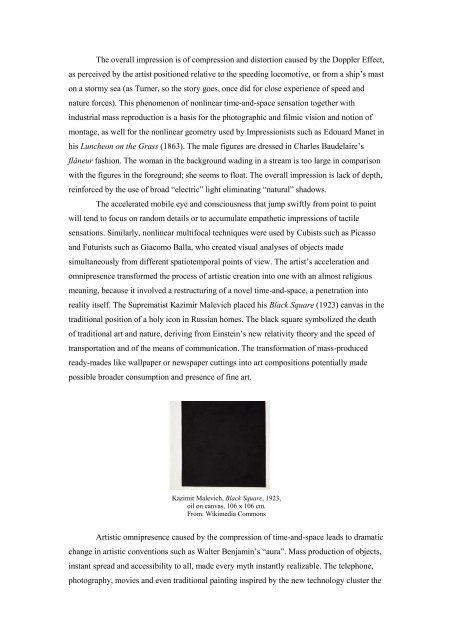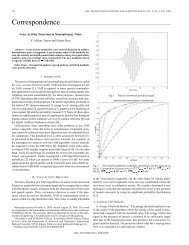Time - space compression in cyberspace art - Signal & Image ...
Time - space compression in cyberspace art - Signal & Image ...
Time - space compression in cyberspace art - Signal & Image ...
Create successful ePaper yourself
Turn your PDF publications into a flip-book with our unique Google optimized e-Paper software.
The overall impression is of <strong>compression</strong> and distortion caused by the Doppler Effect,<br />
as perceived by the <strong>art</strong>ist positioned relative to the speed<strong>in</strong>g locomotive, or from a ship‟s mast<br />
on a stormy sea (as Turner, so the story goes, once did for close experience of speed and<br />
nature forces). This phenomenon of nonl<strong>in</strong>ear time-and-<strong>space</strong> sensation together with<br />
<strong>in</strong>dustrial mass reproduction is a basis for the photographic and filmic vision and notion of<br />
montage, as well for the nonl<strong>in</strong>ear geometry used by Impressionists such as Edouard Manet <strong>in</strong><br />
his Luncheon on the Grass (1863). The male figures are dressed <strong>in</strong> Charles Baudelaire‟s<br />
flâneur fashion. The woman <strong>in</strong> the background wad<strong>in</strong>g <strong>in</strong> a stream is too large <strong>in</strong> comparison<br />
with the figures <strong>in</strong> the foreground; she seems to float. The overall impression is lack of depth,<br />
re<strong>in</strong>forced by the use of broad “electric” light elim<strong>in</strong>at<strong>in</strong>g “natural” shadows.<br />
The accelerated mobile eye and consciousness that jump swiftly from po<strong>in</strong>t to po<strong>in</strong>t<br />
will tend to focus on random details or to accumulate empathetic impressions of tactile<br />
sensations. Similarly, nonl<strong>in</strong>ear multifocal techniques were used by Cubists such as Picasso<br />
and Futurists such as Giacomo Balla, who created visual analyses of objects made<br />
simultaneously from different spatiotemporal po<strong>in</strong>ts of view. The <strong>art</strong>ist‟s acceleration and<br />
omnipresence transformed the process of <strong>art</strong>istic creation <strong>in</strong>to one with an almost religious<br />
mean<strong>in</strong>g, because it <strong>in</strong>volved a restructur<strong>in</strong>g of a novel time-and-<strong>space</strong>, a penetration <strong>in</strong>to<br />
reality itself. The Suprematist Kazimir Malevich placed his Black Square (1923) canvas <strong>in</strong> the<br />
traditional position of a holy icon <strong>in</strong> Russian homes. The black square symbolized the death<br />
of traditional <strong>art</strong> and nature, deriv<strong>in</strong>g from E<strong>in</strong>ste<strong>in</strong>‟s new relativity theory and the speed of<br />
transportation and of the means of communication. The transformation of mass-produced<br />
ready-mades like wallpaper or newspaper cutt<strong>in</strong>gs <strong>in</strong>to <strong>art</strong> compositions potentially made<br />
possible broader consumption and presence of f<strong>in</strong>e <strong>art</strong>.<br />
Kazimir Malevich, Black Square, 1923,<br />
oil on canvas, 106 x 106 cm.<br />
From: Wikimedia Commons<br />
Artistic omnipresence caused by the <strong>compression</strong> of time-and-<strong>space</strong> leads to dramatic<br />
change <strong>in</strong> <strong>art</strong>istic conventions such as Walter Benjam<strong>in</strong>‟s “aura”. Mass production of objects,<br />
<strong>in</strong>stant spread and accessibility to all, made every myth <strong>in</strong>stantly realizable. The telephone,<br />
photography, movies and even traditional pa<strong>in</strong>t<strong>in</strong>g <strong>in</strong>spired by the new technology cluster the















